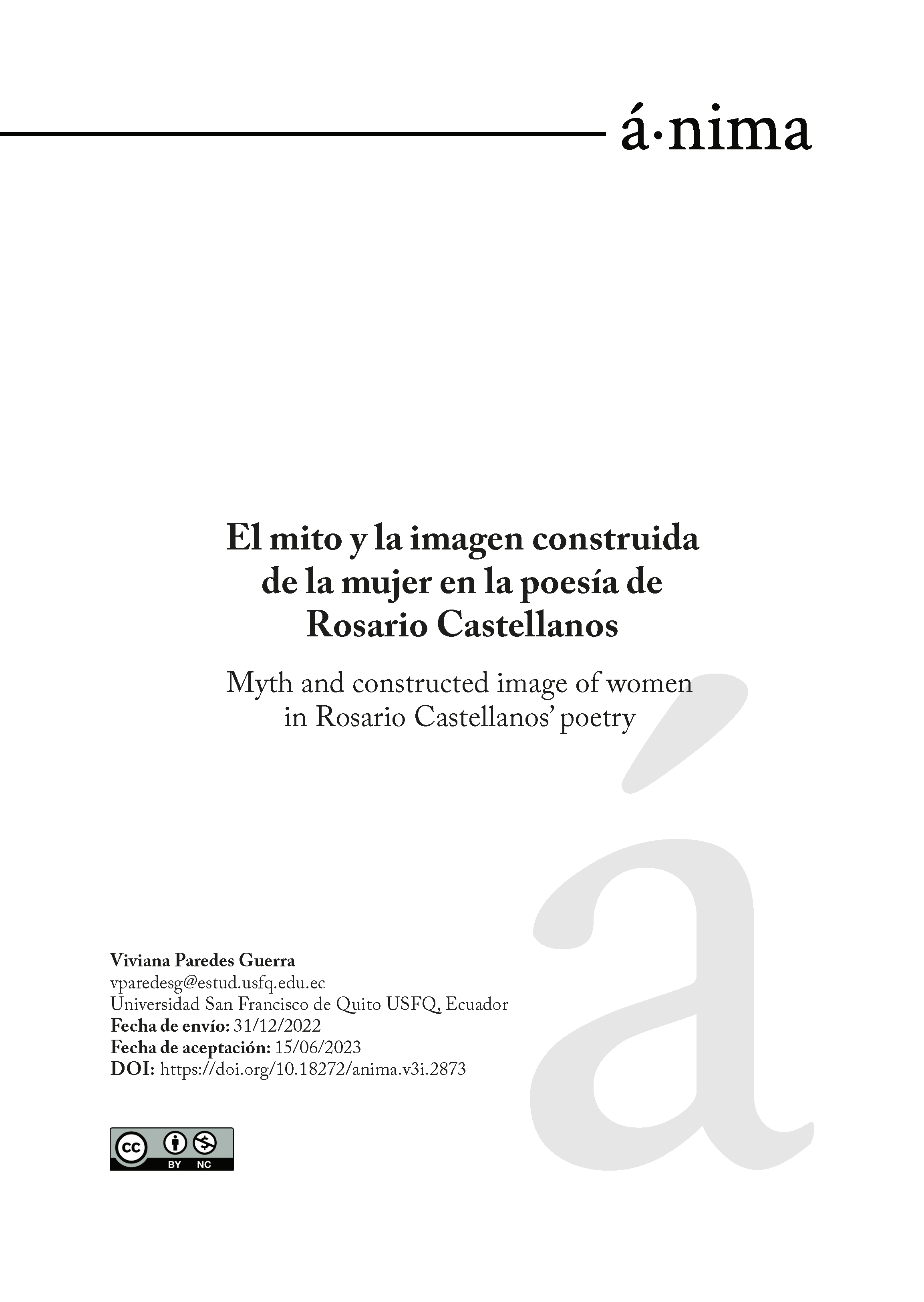she/her Myth and the constructed image of women in Rosario Castellanos’ poetry
DOI:
https://doi.org/10.18272/anima.v3i.2873Keywords:
Rosario Castellanos, mythification, femineity and beauty, female poetry, female subversion, demystificationAbstract
Myth, as an instrument of power over women, is one of the issues that Rosario Castellanos, Mexican feminist poet, explores in her poetic work called Poesía no eres tú. In her latest literary works (En la tierra de en medio, Otros poemas, and Viaje Redondo), which Castellanos recognizes as her more mature and complete works, she proposes the rejection of the mythologized image of women. In consequence, she recreates a new and own female identity defined as a truthful way of being. However, what are the literary myths constructed about women that have distanced them from their human condition? How to subvert the definitions of beauty and femaleness and allow them to build an authentic image? This paper analyzes Rosario Castellanos' views about the constitution of women's image as a myth, as well as her solution to this problem, through awareness and the destruction of society's models of beauty and femininity, so that women may construct their own demystified identity.
Downloads
References
Castellanos, Rosario. Poesía no eres tú. Fondo de cultura económica, 1972.
————. Mujer que sabe latín. Fondo de cultura económica, 1973.
————. El eterno femenino. Fondo de cultura económica, 1975.
Cresta de Leguizamon, María Luisa. “En recuerdo de Rosario Castellanos.” La Palabra y el Hombre, no. 19, 1976, pp. 3-18, cdigital.uv.mx/handle/123456789/4125. Consultado el 30 de diciembre de 2020.
Darío, Rubén. “Venus.” Poesía, editado por Ernesto Mejía Sánchez, Fondo de Cultura Económica, 1952, p. 175, biblioteca.clacso.edu.ar/clacso/se/20190904041625/Poesia_Ruben_Dario.pdf
Estrella, Jennifer. “La mujer se escribe a sí misma: Ensayismo y ontología en Rosario Castellanos y Rosario Ferre.” INTI, no. 46/47, 1997, pp. 83–94. JSTOR, www.jstor.org/stable/23286442. Consultado el 30 de diciembre de 2020.
Lindstrom, Naomi. “‘Rosario Castellanos’: Representing Woman's Voice.” Letras Femeninas, no. 2, vol. 5, 1979, pp. 29–47. JSTOR, www.jstor.org/stable/23022077. Consultado el 30 de diciembre de 2020.
Martínez, Luis. “Literatura y mito: desmitificación, intertextualidad, reescritura”. Revista Signa no. 22, 2013, pp. 481-496,
“Mito”. Diccionario de la Real Academia Española. 23ra edición, Real Academia Española, 2020, dle.rae.es/mito
Renz, Ursula. “From Philosophy to Criticism of Myth: Cassirer's Concept of Myth.” Synthese, no. 1, vol. 179, 2011, pp. 135–152. JSTOR, www.jstor.org/stable/41477399. Consultado el 30 de diciembre de 2020.
Rojas, Lourdes. “La indagación desmitificadora en la poesía de Rosario Castellanos.” Diálogos: artes, letras, ciencias humanas, no. 3 (99), vol. 17, 1981, pp. 37–42. JSTOR, www.jstor.org/stable/27934504. Consultado el 30 de diciembre de 2020.
Villegas, Juan. “Mitificación de la anécdota amorosa en un poema de Gabriela Mistral.” Revista Chilena De Literatura, no. 7, 1976, pp. 37–45. JSTOR, www.jstor.org/stable/40355972. Consultado el 30 de diciembre de 2020.
Woolf, Virginia. “Profesiones de mujeres.” School of feminism, nov-2019, pp. 1-6, issuu.com/schooloffeminism/docs/virginia_woolf_-_profesiones_para_mujeres._angel_d

Downloads
Published
How to Cite
Issue
Section
License
Copyright (c) 2023 Viviana Paredes Guerra

This work is licensed under a Creative Commons Attribution-NonCommercial 4.0 International License.
Los autores que publiquen en la revista aceptan los siguientes términos:
- Los autores conservarán sus derechos de autor y garantizarán a la revista el derecho de primera publicación de su obra, la cual estará simultáneamente sujeto a la Licencia de reconocimiento de Creative Commons que permite a terceros compartir la obra siempre que se indique su autor y su primera publicación esta revista.
- Los autores podrán adoptar otros acuerdos de licencia no exclusiva de distribución de la versión de la obra publicada, pudiendo de esa forma publicarla en un volumen monográfico o reproducirla de otras formas, siempre que se indique la publicación inicial en esta revista.
- Se permite y se recomienda a los autores difundir su obra a través de Internet:
- Antes del envío a la revista, los autores pueden depositar el manuscrito en archivos/repositorios de pre-publicaciones (preprint servers/repositories), incluyendo arXiv, bioRxiv, figshare, PeerJ Preprints, SSRN, entre otros, lo cual puede producir intercambios interesantes y aumentar las citas de la obra publicada (Véase El efecto del acceso abierto).
- Después del envío, se recomiendo que los autores depositen su artículo en su repositorio institucional, página web personal, o red social científica (como Zenodo, ResearchGate o Academia.edu).






